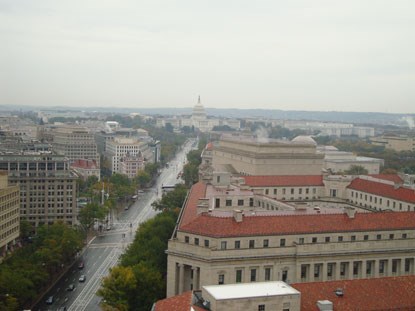
November 16, 2011 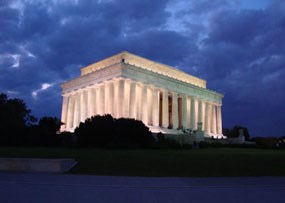
No one defines resilient leader better than Abraham Lincoln, and after visiting the Lincoln Memorial and Ford Theater, I can proudly say that he is now my favorite President. Lincoln ferociously led the Union to victory during the greatest Civil War, while ending slavery, and gaining the equality for all men in the same breath. You cannot be a leader if you don't have followers, and Lincoln had plenty of them. He was a passionate leader, who showed much empathy for his people. If you take a close look at the statue of Lincoln in the Memorial, you will see one of his hands is clenched to show his resiliency, and the other is open to show his compassion. Old Abe was a thinker before his time, and it's because of his resiliency, we are now able to live in a unified and free country. There has been no other time in history that we as Americans showed as much unity and teamwork than during the Great Depression and World War II. Franklin Delano Roosevelt (FDR) was the president during this era, and his Memorial takes you through this harsh time, and offers a revelation about the teamwork it took to persevere. There is no doubt that during FRD's presidency from 1933-1945 the U.S was knocked down; the market crashed, crops turned to dust, and thousands of men were being shipped off to war. The only way to get back on our feet was to work as one united nation, under the leadership of our optimistic coach, FDR. He was able to inspire and instill hope to a lost and desperate nation. All across the country people began rationing goods, woman took over the working role of our men overseas, and everyone came together to get through the hard times. Looking back to this era should remind us that with teamwork we can overcome anything. Our national endurance is dependent on every single one of us. 
There have been multiple times of adversity within American History, and it was those times that have made our country stronger. Although Lincoln signed the 13th Amendment freeing all slaves, people of color continued to be segregated and treated unfairly for many years after. The man that helped our country overcome these dark times was Dr. Martin Luther King Jr. (MLK). He was not only a great leader, but his struggle for justice and equality is a testament to overcoming adversity. At the new MLK Memorial, you will see one slab of granite rock, cut from a large mountain behind, and pushed forward. On the cut rock in the foreground is a sculpture of Dr. King and an engraved quote that reads, "From the mountain of despair comes the stone of hope." It only took a spark to get the fire of the Civil Rights movement going. It was the hope and the dream of MLK, his willingness to overcome adversity, and his great leadership, that completely transformed our nation forever. By taking the time to learn about some of our great historical leaders, I was able to put all I had learned in my Fundamentals 5 class into perspective. It has become clear to me that in order to lead, you need someone to follow; and to get followers, you need to show a commitment to your team. Most importantly they have reminded me that in the most desperate and adverse times, one must transform themselves into a stone of hope. The Memorials honor the legacy each person has left behind, and they serve as reminders to "be the change you want to see in the world." During my visit I was able to connect to some of our greatest leaders, and I appreciate their resiliency in transforming our country for the better. Protecting and preserving the stories and legacies of these amazing people will continue to inspire others for many years to come, and because of this, everyone should take a trip to Washington DC. November 1, 2011 
NPS Photo 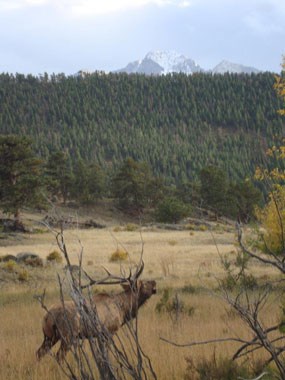
NPS Photo You may still see plenty of elk around the open meadows in the park, but the dramatic show of their breeding season has slowly come to an end. The elk rut is definitely the highlight of a Rocky Mountain fall, and to watch a massive bull elk do everything in his power to attract females, is a perfect example of nature's true love story. Male's parade around, flaunting their antlers, and serenading the females with powerful bugles. It is ultimately up to the females to pick their sire, and only the healthiest and most fit animals will breed. This ensures that the best genes get passed on to the next generation, and it secures the future of these animals in Rocky Mountain National Park. This year the aspen trees also put on a show with all the moisture they received from late snowfall and the warm temperatures in August. The brilliant yellows, electric oranges and rosy reds, scattered through the dark green hue of the coniferous forest, were a feast for the eyes. It's as if the trees want one last hurrah before they go to sleep for the winter season. The vibrant aspen leaves have since fallen to the forest floor, exposing the bare bone of white trunk, which will soon be covered by snow. 
NPS Photo The snow has come early once again, and signals the beginning of winter. The plants and animals know that fall is a time for preparation, and they are primed for the harshness of the winter season. The fall and winter may be seasons of starkness and death, but they are necessary for the creation of life. Come May the aspen will bare leaves once again, and the female elk will have their young. The transition of the fall season reminds me that everything is interconnected, and that the circle of life is truly amazing! 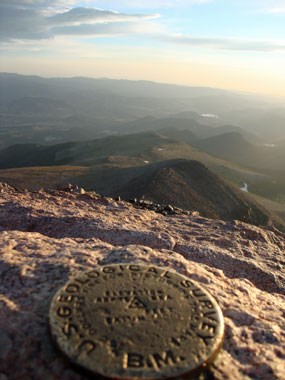
NPS PHOTO September 24, 2011 I started the climb from the Longs Peak Trailhead at 12:45 AM. It is a strange feeling to be on a trail in the middle of the night, but it is all part of the Longs experience. You need to start the hike early enough to get up and down from the peak before thunderstorms roll through. I would highly suggest planning a trip on a full moon night, because of the ample amount of light that guides your way. It is a magical feeling to see your shadow on the forest floor from the light beaming from a full moon. The moon was actually so bright, that we didn't even need headlamps for most the way, until we hit the Boulder Field. Once I saw the scree field of boulders we had to transverse through, I knew from that point on, things were about to get difficult. Walking through a sea of massive rocks is no easy task, especially in the dark. You need to have very careful footing to avoid sprains or injuries. We slowly crept through the rocks, making it closer and closer to the Keyhole. We finally got to the Keyhole around 4:15 in the morning, rested and replenished ourselves with a snack. We were going to wait for daybreak to continue the climb onto The Ledges, but the winds were chilling us to the bone, and the only way to stay warm was to keep moving. After careful consideration, and because there was plenty of moonlight, we decided to continue along our journey. 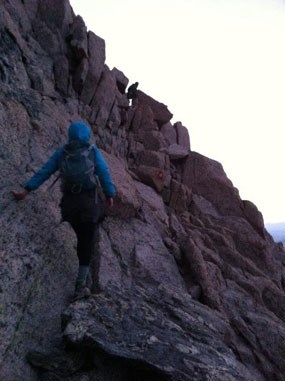
NPS Photo Once we climbed through the Keyhole, immediately we were faced with the challenge of making it across The Ledges. These ledges sit on top of several large cliffs, and in some sections you have to cross narrow, slippery, rock slabs above steep drop-offs. There are red and yellow bull's-eyes painted on the rocks that mark the easiest route, but you still need heightened awareness of both hand and foot placements as you make your way across. I had my eyes glued to the bull's-eyes, avoided peering over the edge, and kept reminding myself that "slow and steady wins the race." Once we made it across The Ledges, I was happy to get away from the steep drop-offs, until I saw the next section of the climb. I stood there staring straight up at The Trough, and I thought, "oh no, here we go again." The Trough is a gully filled with loose rock that climbs about 1,000 ft in a ½ mile. You literally need to use your arms, legs, knees and even your butt to get to the top. This was probably the most difficult part of the climb for me. Now and again I was distracted from difficulty when I saw the mountains below me splashed with the light of a new day. The climb is both physically and mentally exhausting, but yet all I could think about was making it to the top. After The Trough, you have to make it past The Narrows, which is probably the scariest part of the trip. This section of trail crosses a sheer vertical rock face on a narrow ledge, with a 2,000ft drop-off reminding you to hold on for dear life. A series of boulders and hand holds will assist you on this constricted ledge, but there is really no way to avoid looking down. Once you get through The Narrows, you are looking at The Homestretch. The Homestretch is a polished granite slab that guards the summit of the mountain. This section is another vertical climb that requires scrambling with your hands and feet. This rock has definitely felt the wear and tear from the thousands of people who have climbed it, and the eroded rock can be slippery. At this point I was feeling a little weak and tired, but got my second wind knowing that the summit was close. 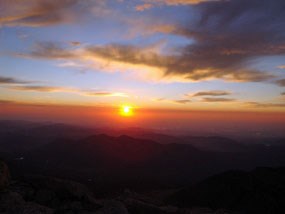
NPS PHOTO Getting to the summit and being greeted by sunrise on the eastern horizon was like no other experience I have ever had in RMNP. To be on top of the world, at 14,259ft is the ultimate high. The mountains that were once towering from above now look like an ocean of rippled rolling hills. I felt such a sense of accomplishment as I sat on the top, mostly because I can now look up at the diamond face, visible from most places in the park, and finally say, "I've been up there." Climbing Longs is NOT for the weak of heart, and park staff spend a lot of time and resources stressing the difficulty of the assent to the general public. Be sure to educate yourself about the climb before you go! For most of the year, climbing Longs Peak is in winter conditions, which requires winter mountaineering experience and the knowledge and use of specialized equipment. Disregard for the mountain environment has meant danger, injury and even death. Please consult with a ranger, pamphlets, or the park website to get informed before you start your own journey to the top of the world. Sources for climbing information: https://www.nps.gov/romo/planyourvisit/longspeak.htm 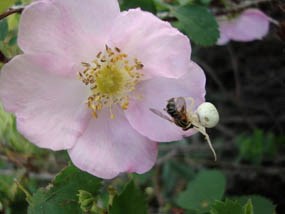
NPS Photo July 25, 2011 The best smelling flower found at lower elevations is the wild rose. This rose is a five-petaled pink flower with a yellow center, and it grows on large shrubs (2-3 ft. tall). The scent of this flower is absolutely intoxicating, and it's no wonder that swarms of pollinators are never too far away.Another bug that uses this flower is the crab spider. It has very good camouflaging capabilities, and will lie motionless within a flower for days at a time waiting for its prey. The front two legs of the spider are often larger and stronger than the other six, are held sideways, ready to catch the prey as it lands in the flower. The poor bees and butterflies that are lured in by the yummy smell of the wild rose have no idea what's coming, until they become the crab spider's next meal. 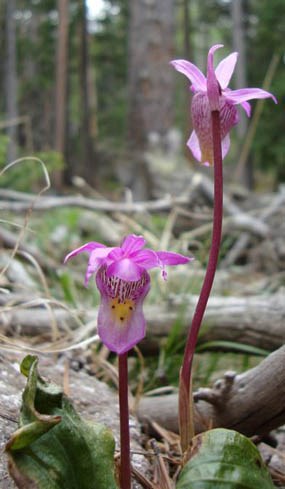
NPS Photo Another flower that people come from all over the country to see is the Calypso Orchid. This small delicate flower grows in the moister subalpine forest, found above 9,000 feet of elevation. The common name for this flower is fairy slipper, or lady slipper because of the flower's gorgeous shape. They are sometimes hard to spot because they are small (2-3 inches), and grow close to the ground. But keep your eyes peeled for this small purple flower, a glimpse of this natural work of art is definitely a treat. 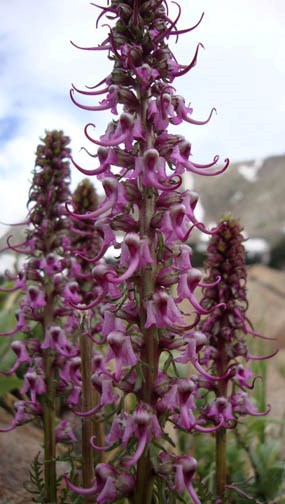
NPS Photo A uniquely shaped flower is the Elephantella, also known as little elephant head. You can find this in wetlands, marshy meadows and river banks throughout the park. The little flower heads grow on a tall un-branched stem, in a dense cluster. This flower looks just like it sounds; it takes the identical shape of an elephant's head. It's crazy that a mountain wildflower can look so much like a large African mammal! If you ever encounter this flower, take a close look, the bold face, flappy ears, and upturned trunk never fail to amaze. 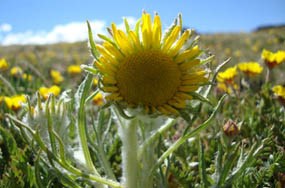
NPS Photo The miniaturized flowers of the Alpine Tundra are my favorite, because of their proven resiliency. Over hundreds of years these flowers have figured out how to survive the harsh wind, cold, and sunlight ever present at 11, 500 feet above sea level. Many of these tiny plants go unnoticed, but there is one that towers over them all. The Alpine sunflower, also known as Old Man of the Mountain, is the giant of the tundra world. It takes 7-25 years for this plant to store enough energy within its roots to sprout a single large yellow flower on a small 4-inch stem. The flower will then die, its mission complete of spreading its seeds. Next time you spot this flower, hopefully you will appreciate the time and the patience it took for it to put on its big show for all of us to enjoy. Each flower of Rocky Mountain National Park is unique in its own way, but yet all of them add to the natural beauty of our landscape. Hopefully by reading about some of these amazing plants, you are now inspired to get out and take a look for yourself. Humans are very busy creatures, and life tends to move fast, but I encourage everyone to take some time, and stop to smell the flowers! Your comments are welcome and may be posted on this website. To submit your comment by email, please click here. July 1, 2011 Chuck Stalker and Paul Barber are two members of the roads crew, and they have been plowing Trail Ridge Road for over 50 years combined. This was definitely one of their more frustrating years on the job, and the road hadn’t opened up this late in the season for decades. There were tons of snow in the high country, the biggest drift they plowed through this year was near Rock Cut that measured 24 feet. With that amount of snow, the plowing is slow going, and at some points the crew was only able to clear ¼ of a mile of the road per day. 
NPS Photo Both guys agreed that the most challenging part about the clearing was the late snow storms, as well as the wind.“We basically had to start plowing all over again four separate times,” said Barber “because of the snow drifting back on to the road at night.” Stalker added, “Some spots on the road had 17 foot drifts of new snow, after the road had all been cleared just the day before.” As you can tell it was a trying year, but the plows went up day after day until the job was done. 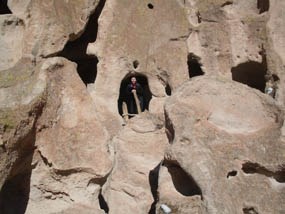
May 19, 2011 While on a road trip from North Carolina back to Colorado I was able to stop at Bandelier National Monument and Great Sand Dunes National Park. Each one had something different to contribute to our nation's land preservation system. Bandelier National Monument, in New Mexico was set aside as a place of cultural significance because of the many archeological sites left by the ancestral Pueblo people and early Spanish explorers. At the monument you can explore what's left of ancient dwellings, and search for the many petroglyphs sketched on the canyon walls. 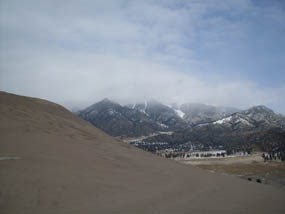
Great Sand Dunes National Park and Preserve on the other hand was protected because it is home to the tallest sand dunes in the country. Sand sediments that once blew across the San Luis valley got trapped against the high peaks of the Sangre de Cristo Mountains, and piled up over time to create great dunes of sand we see there today. This park is located in southern Colorado and it's definitely worth the stop if you are going to be in the area. Most recently I went further out west and visited the spectacular Yosemite National Park, in northern California. For anyone considering a trip out there, I highly suggest going in late April. The waterfalls were spewing off the high cliffs, the weather was not too hot and not too cold, and everything was so GREEN! Yosemite was one of the very first places to be recognized as a place that needed to be protected, by the famous conservationist John Muir. He wrote beautifully and passionately about the park, and really got people thinking about the many natural wonders within our country. The entities within the National Park System do provide more than just protection; they give us recreational opportunities, enhance scenic beauty, and offer a chance for emotional and spiritual renewal. I encourage all of you to go and experience the many different places that are being protected for our enjoyment. Each preserved unit within the National Park System is here for a purpose, and each unique place adds to the diversity of plants, animals, and history that will live on for the enjoyment of future generations. 
March 30, 2011 Memorable Experience It's hard for me to believe that I am coming up on my year anniversary of working at Rocky, and it seems as though time has flown by. Since day one I keep pinching myself because this is truly a dream job for me. I want to thank everybody that has helped me get to where I am today, as well as my wonderful coworkers that have taught me so much and have accepted me with open arms. I am really starting to feel at home right here in the mountains, and I can't wait to see what the year brings. Each ranger-led program I give still feels like the first, and honestly I don't think the excitement and joy of teaching people about this beautiful park will ever go away. 
NPS Photo The most recent program I gave has turned out to be the most memorable experience yet. I gave a Full Moon Walk, where I lead a group of visitors out to discover the world of night under the light of the moon. I had spent weeks preparing the talk and planning the perfect place to give the walk, because this was my very first night hike. Truthfully I was way more nervous about not seeing the full moon than leading the program, but all my positive thoughts about having a clear night paid off. A cloudless sky, a windless night, and the biggest moon we've experienced in 18 years, made my job of connecting people to the resource pretty easy. Part of the program was to have my group just stand in silence, and really take in the experience they were having. There is something really powerful about the night and the full moon, and I will never forget the energizing feeling I had inside as we all allowed ourselves to be fully embraced by the night. There are not too many opportunities to sit in complete silence these days, nor are there many places that are not affected by light pollution. National Parks are not just places to protect the wildlife and the land, but also to provide memorable experiences you may not get anywhere else. I encourage everyone to get out at night, embrace its power force, and create new memories. Having new experiences and doing things that take you out of your comfort zone create the memories that last a lifetime. 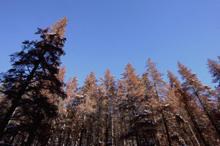
March 2, 2011 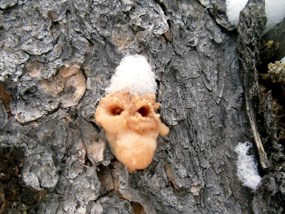
NPS Photo A tree that falls victim to the MPB dry out, their root system decays, and the tree's support system gets weaker and weaker. It eventually loses all strength and becomes much more susceptible to falling over. The species of pine that has been most affected by the beetle is the Lodgepole pine. Lodgepoles like to crowd together for protection, and they have very shallow root systems. The protection of a stand is severely compromised once 30% of the trees fall over. This is one of the major reasons we are removing hazard trees in high visitor use areas like campgrounds, picnic areas, road corridors, and trailhead parking areas. We want you to be safe. 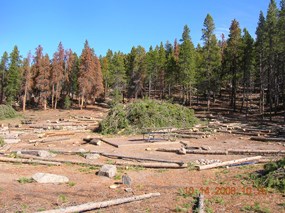
When people see a dry dead tree, they immediately think, "fire." Fire is an obvious threat, but sometimes it's the unnoticed threat that will get you hurt. Falling trees are an ever-present hazard. Always check the forecast before setting off on a hike, and be aware if the weather is calling for high winds or following a snowstorm when branches are heavy with snow. Try to avoid large standing patches of dead or red trees. If you come across patches of red trees try to hike quickly through those areas. When you stop for lunch or a snack look around to pick the best spot to stop. Most importantly, always keep your eyes and ears open, staying aware of your surroundings. Being an alert hiker is being a safe hiker, especially on windy days. February 4, 2011 Plenty of animals choose to escape down south where the weather is warmer by migrating long distances, like most of the birds in the park. While other animals, like elk and deer, choose shorter migration routes from higher elevations to lower elevations. It is very hard for some animals to move and forage in areas that have deep snowpack…they just don't have the right type of foot. This is why most of the elk you see along Trail Ridge Road in the summer are now at lower elevations where it's easier to find food because there isn't as much snow. 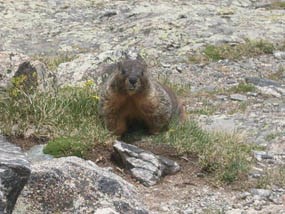
NPS Photo by Ranger Chelsea If I were an animal I would choose to sleep the winter season away by hibernating. The most notorious winter hibernator is the yellow-bellied marmot. These guys are asleep nine months out of the year, and they practically shut down all bodily functions as they nap. While hibernating, marmots drop their body temperatures to 40 degrees, they breathe once every 3-6 minutes, and their heartbeat drops to one beat per minute. The main reason animals sleep like this is due to the lack of food during the winter season. They fatten themselves up all summer to prepare for a long winter's nap. 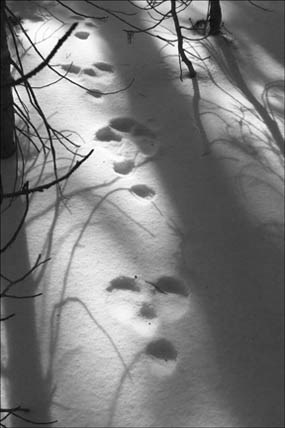
NPS Photo by Ann Schnolau Last but definitely not least, there are many animals that stay active all winter long, but have to change with the onset of winter if they are to survive. These animals are called snow-lovers, or chionophiles, and only inhabit the snowiest regions of the park. They tell stories of their activity through tracks left on top of the snow. One track you will see while hiking near Bear Lake belongs to the snowshoe hare. Over time the hare has changed the shape of its back foot, to increase its ability to move on top of the snow. It has also learned to change the color of its coat from brown to white which makes it hard for predators to see it. I have always been an animal-lover, and I think by observing them we can learn a lot about our own lives. Winter is a season of scarcity and survival. Watching animals this time of year has taught me about resiliency, and how to get through difficult situations. The animals also show us that life doesn't stop just because a little snow fell on the ground! So, take some tips from the hare, strap on some snowshoes, and see what life lessons you may learn from observing the park's amazing wildlife. 
NPS Photo by Ranger Chelsea Your comments are welcome and may be posted on this website. To submit your comment by email, please click here. January 21, 2011 
NPS Photo 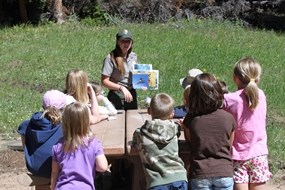
NPS Photo While doing these programs, I think of myself as a teacher, and luckily I have one of the best classrooms in the world. It's great when people take the time to learn something about the park, so I definitely seize the opportunities to show off nature's amazing assets. It really does bring joy to me to see a person, who has walked through the woods a thousand times before, actually take the time to smell the intoxicating vanilla aroma coming from the bark of a sun-soaked ponderosa tree. And to see a child's face as they struggle to hold a 20 lb elk antler above their head keeps me coming back to work day after day. Children are the best to work with, mostly because they think rangers are really cool, but also because they are really smart. I love asking a child a question and watching the wheels spin around in their head formulating an answer. A word to the wise, A CHILD IS NEVER WRONG, and they are some of the smartest people in the world. It might not have been the answer you were expecting, but give them time to explain and their world will open up to you. Children are imaginative, simplistic, and to-the-point type of people. They know how to have fun and they are constantly learning from the people and the world around them. Their hunger for knowledge and their thirst to learn gives me great hope that the future is in good hands. What we are protecting today will be their's tomorrow, so it is my job to get these little buggers caring and protecting the wilderness we have left. 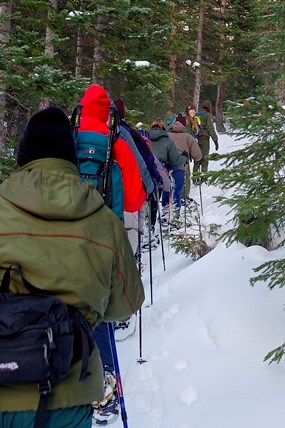
NPS Photo by Ann Schonlau We are currently running snowshoe winter ecology walks, skins and skulls talks, and a Saturday evening film series throughout the winter, so brave the weather and come on up for a visit. You can find program times and locations in the park's winter newspaper or right here on our website. One of the founding interpreters Freedman Tilden said, "Through interpretation understanding, through understanding appreciation, and through appreciation protection." Hopefully I will see some of you at a program soon! |
Last updated: June 21, 2022
